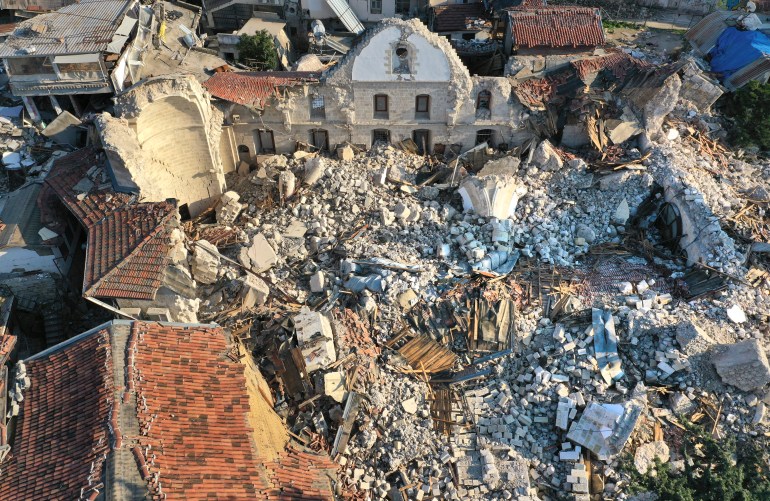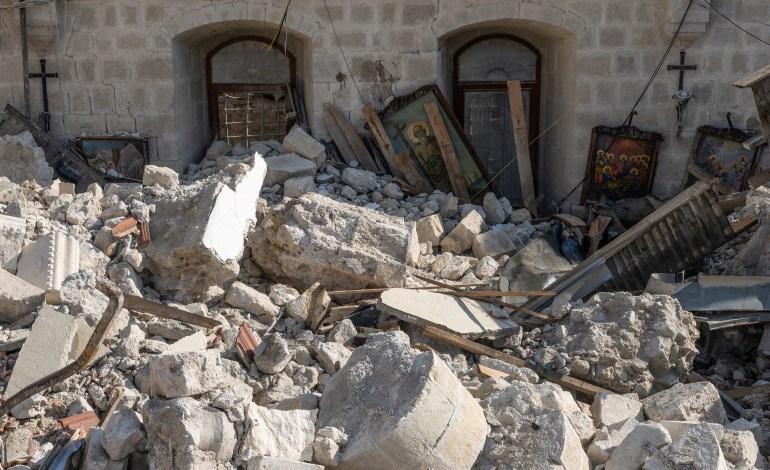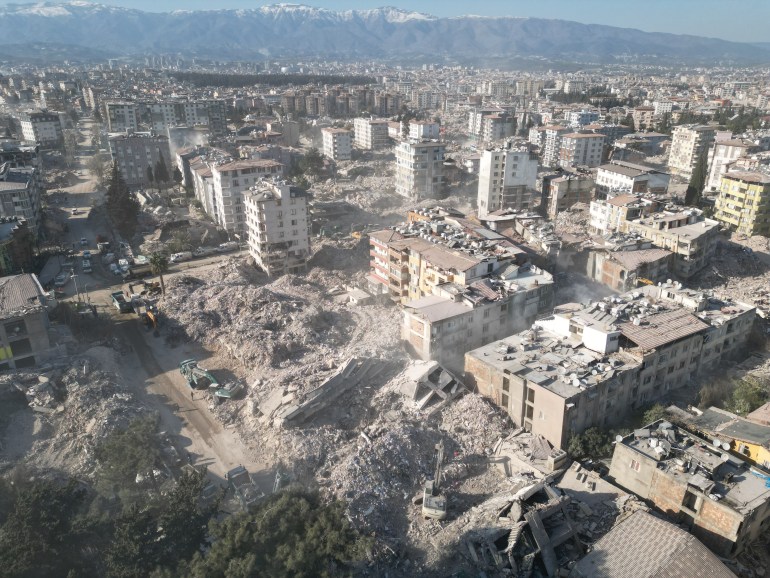WORD NEWS
Quake-hit Antakya communities search position in saving wealthy heritage | Turkey-Syria Earthquake Information
Antakya, Turkey – When Hasan Sivri was a highschool scholar in Antakya’s Previous Metropolis, he used to cross the Protestant church day-after-day.
His route would typically take him previous different church buildings, mosques and a synagogue, too. Church bells mingled with the decision to prayer, and the streets of the traditional metropolis resounded with totally different languages – all serving as a timeless reminder of its vibrant cultural variety.
“It was actually distinctive and had a distinct environment than different cities in Anatolia or Turkey,” Sivri, an Arab Alevi, informed Al Jazeera. “It is called a ‘metropolis of peace’. So many pals of mine had been from totally different ethnic, ideological and non secular backgrounds.”
On February 6, two highly effective earthquakes devastated swaths of southern Turkey and northwest Syria, killing greater than 50,000 individuals and destroying tens of hundreds of buildings.
Antakya, traditionally often called Antioch, was significantly hard-hit.
![This mosque is actually a former Byzantine church, transformed into a mosque in the 13th century. "Habib" means "beloved" and "neccar" means "carpenter." Habib-i Neccar was killed by pagans while he was trying to protect two messengers sent to Antioch by Prophet Jesus.[Getty Images]](https://www.aljazeera.com/wp-content/uploads/2023/03/GettyImages-471200771.jpg?w=725&resize=725%2C482)

Sivri, now a 33-year-old freelance journalist dwelling within the Turkish capital, Ankara, reached the Previous Metropolis on the night of February 6 and located a lot of it in ruins.
The minaret and dome of the centuries-old Habibi-i Neccar Mosque was a pile of rubble; the Greek Orthodox Church of Antioch had collapsed, thrusting its belfry right into a neighbouring constructing and killing a resident; the town’s synagogue was scored by fissures; and the Protestant church was additionally in ruins.
“Once I noticed these buildings had collapsed, it made me really feel like part of my reminiscences and my world had collapsed with them,” Sivri mentioned.
Within the following days and weeks, as rescue efforts ended, the Previous Metropolis was largely deserted. Those that remained had been pressured to select precarious paths over mountains of rubble that blocked the slender streets.
On the Sunday after the earthquake, about 10 members of the Protestant congregation gathered in entrance the rubble of their church to wish and sing hymns. They had been nonetheless in shock.
Corc Kocamahhul mentioned the constructing was a couple of century outdated and it had been used as a church for the reason that yr 2000.
“We by no means anticipated it might collapse, however sadly Antakya has disappeared and so has our church,” he mentioned, turning into tearful as he talked concerning the metropolis’s plight. “I hope we construct this church once more as quickly as attainable.”
However whereas the Turkish authorities say the restoration of Antakya’s historic buildings will begin imminently, some are cautioning in opposition to a rush to rebuild the town’s heritage and warn that its distinctive character and communities are prone to being misplaced perpetually.
‘We should always care for individuals first’
Antioch was constructed by the Orontes River in 300 BC by Seleucus I Nicator, a number one common of Alexander the Nice and the founding father of the Seleucid Empire, who named it Antioch.
It shortly discovered prosperity as a key buying and selling hub alongside the routes linking the Mediterranean to Asia.
In 64 BC, the strategically positioned metropolis was seized by the Romans and went on to grow to be considered one of their empire’s most vital cities. Over the centuries, it was additionally dominated by the Byzantines, the Arab Rashidun Caliphate, the Seljuks, the Crusaders, the Mamluks and the Ottomans.
Antioch was additionally an early centre of Christianity; it was right here that the disciples of Jesus Christ had been first known as “Christians”.


After World Warfare I, the town and its province of Hatay fell beneath a French mandate and have become the short-lived Hatay State in 1938. Hatay solely joined Turkey the next yr, 16 years after the formation of the fashionable Turkish Republic.
Many Christians and different minorities left Antakya in 1939. The demographics of the town modified considerably within the following many years as Christian and Jewish populations additional dwindled and Syrian refugees started arriving from 2012. Nonetheless, Antakya, house to some 200,000 individuals, retained extra ethnic and non secular variety than most different elements of Turkey.
All through its historical past, the town has been destroyed and rebuilt a number of occasions because of earthquakes and battle. Little stays of the town’s Hellenistic interval. The Habibi-i Neccar Mosque, beforehand a pagan temple and a church, was destroyed by an earthquake in 1853 and rebuilt by the Ottomans.
The tremors in early February killed an estimated 20,000 individuals in Hatay, in accordance with its metropolitan mayor, and many of the province’s buildings both collapsed or had been severely broken.
Many non-religious landmarks had been additionally destroyed or broken, together with the outdated bazaar, the Affan espresso home relationship again to the 1910s, and the 1927 constructing used as a parliament for the Hatay State.
![City of Antakya (Hatay), Turkey - stock photo Aerial view of the city of Antakya, also called Hatay, in southern Turkey. In ancient times the city was known as Antioch. The Orontes River flows through the middle of the city. [Getty Images]](https://www.aljazeera.com/wp-content/uploads/2023/03/GettyImages-1652116271.jpg?w=724&resize=724%2C483)

The federal government, which faces presidential and parliamentary elections in Could, is eager to push forward with reconstruction efforts.
Yahya Coşkun, deputy common director of cultural heritage and museums at Turkey’s tradition and tourism ministry, informed Al Jazeera {that a} harm evaluation had nearly been completed in Antakya and that the essential items of the historic buildings had been being salvaged.
He mentioned {that a} restoration course of, led by the ministry and performed in cooperation with educational consultants and nationwide and worldwide cultural businesses, will start in March.
“The precedence shall be given to constructed public heritage together with monuments, mosques, church buildings, historic homes … then the privately owned heritage shall be managed,” he mentioned.
“We’ve plans and reliefs of many of the historic buildings. These buildings shall be restored in accordance with [the] authentic plans and the unique supplies shall be used as a lot as attainable.”
Emre Can Dağlıoğlu, an editor on the platform Nehna, a collective of Arabic-speaking Orthodox Christians in Antakya, informed Al Jazeera that – whereas well being, hygiene and lodging wants should be tackled urgently – the rebuilding of the town’s heritage needs to be thought of rigorously earlier than main reconstruction begins.
“It needs to be undertaken collectively, not solely by the federal government from the highest down however from all sectors and native organisations and associations and people, to consider how we must always rebuild the town from scratch,” he mentioned.
Some communities are prone to complete erasure. Town’s Jewish neighborhood, maybe numbering fewer than 20 individuals, misplaced its chief and his spouse within the earthquake.
Dağlıoğlu mentioned that individuals displaced by the earthquake wanted to be helped to return to Antakya to revive its variety together with the buildings. He mentioned he feared the town, the place there may be important opposition to the federal government, could possibly be gentrified or socially engineered.
“What makes Antakya stunning is its distinctive social material, its social coherence, its various inhabitants, and we must always discover a solution to return these individuals – Jews, Armenians, Alevis, Orthodox Christians, Turks, Kurds, Syrian refugees – to the town,” he mentioned.
“We should always care for individuals first, as a result of it’s actually meaningless to rebuild all these non secular websites with out their individuals.”
Tufan Kaya, a member of Koruma Akademisi, a Turkish NGO which research and advises on heritage conservation, mentioned that whereas some restoration initiatives in Turkey have gained worldwide prizes, the nation’s report is mostly poor.
He mentioned restoration is usually marred by low cost tenders awarded to development corporations with out heritage experience that use new supplies and constructing methods which aren’t at all times aesthetically pleasing or as structurally sound. Contracts are handed out in a system based mostly on patronage, regardless of the political occasion, he added.
“Restoration is completely totally different from different elements [of the construction industry]. It’s not a enterprise, it shouldn’t be achieved by tenders given to whoever pays the most affordable value – when you make the restoration that means, the outcomes shall be horrible,” Kaya mentioned.

Many imagine the landmarks might even have been higher protected within the first place.
Regardless of its magnificence, a lot of Antakya was blighted by lots of the similar points present in cities throughout Turkey comparable to haphazard city planning, mind-numbing identikit complexes, and a proliferation of low cost and ugly buildings – a lot of which couldn’t face up to earthquakes as a result of constructing codes weren’t enforced.
Kaya mentioned that historic buildings within the metropolis had been additionally topic to the identical poor enforcement of constructing codes when renovated.
“Turkey’s laws are excellent on paper,” Kaya mentioned. “However, virtually, individuals don’t apply them.”
Coşkun pointed to the dearth of great harm to Antakya’s main museums as proof that the ministry had realized from earlier disasters and was in a position to assemble buildings that might face up to highly effective earthquakes.
“I don’t imagine that we’d require new legal guidelines for the safety of historic buildings [but] vigilant implementation of those present instruments stays an important level,” he mentioned.
‘Misplaced all the pieces however its hope’
These from Antakya or with a robust bond to the town draw power from its lengthy historical past of renewal.
“I imagine that Antakya has actually misplaced all the pieces however its hope,” Dağlıoğlu mentioned.
New civil initiatives involved with rebuilding the town are arising. Nehna is working with native organisations to draft a coverage doc to be despatched to the authorities. The civil platform Antakya Yeniden (Antakya Once more) goals to deliver collectively teachers, architects, archaeologists and artists.
Kaya mentioned native individuals also needs to have a say in how the buildings are reconstructed to protect their id.
“The sort of data that needs to be inherited from the previous shouldn’t be determined by bureaucrats from Ankara, it is best to get native individuals concerned,” he mentioned. “In any other case, then they simply construct some vacationer entice that doesn’t inform the actual story of the constructing.”
Hakan Mertcan, an instructional on the College of Bayreuth, Germany, has written and edited a number of books on Antakya, together with Asi Gülüşlüm (which roughly interprets to My Darling with a Rebellious Smile).
Asi (rebellious) can be the Turkish title for the town’s river, and the title references the inhabitants’ welcoming and good-natured spirit, together with their historic resistance to makes an attempt at assimilation or social engineering.
“We can not simply belief the federal government’s efforts,” he mentioned. “They should rebuild the town, however with civil society, the opposition, ecologists, feminists, leftists, and with worldwide organisations.”
Sivri additionally mentioned the town should be rebuilt in a means that returns its earthquake-displaced populace and restores the largely peaceable, harmonious environment alongside the great thing about its historic buildings and monuments.
“If we are able to return and rebuild the town once more [like this], then we are able to once more name it Antakya,” he mentioned.
Trending
-
Bank and Cryptocurrency11 months ago
Cheap Car Insurance Rates Guide to Understanding Your Options, Laws, and Discounts
-
Bank and Cryptocurrency11 months ago
Why Do We Need an Insurance for Our Vehicle?
-

 entertainement5 months ago
entertainement5 months agoHOUSE OF FUN DAILY GIFTS
-
WORD NEWS12 months ago
Swan wrangling and ‘steamy trysts’: the weird lives and jobs of the king’s entourage | Monarchy
